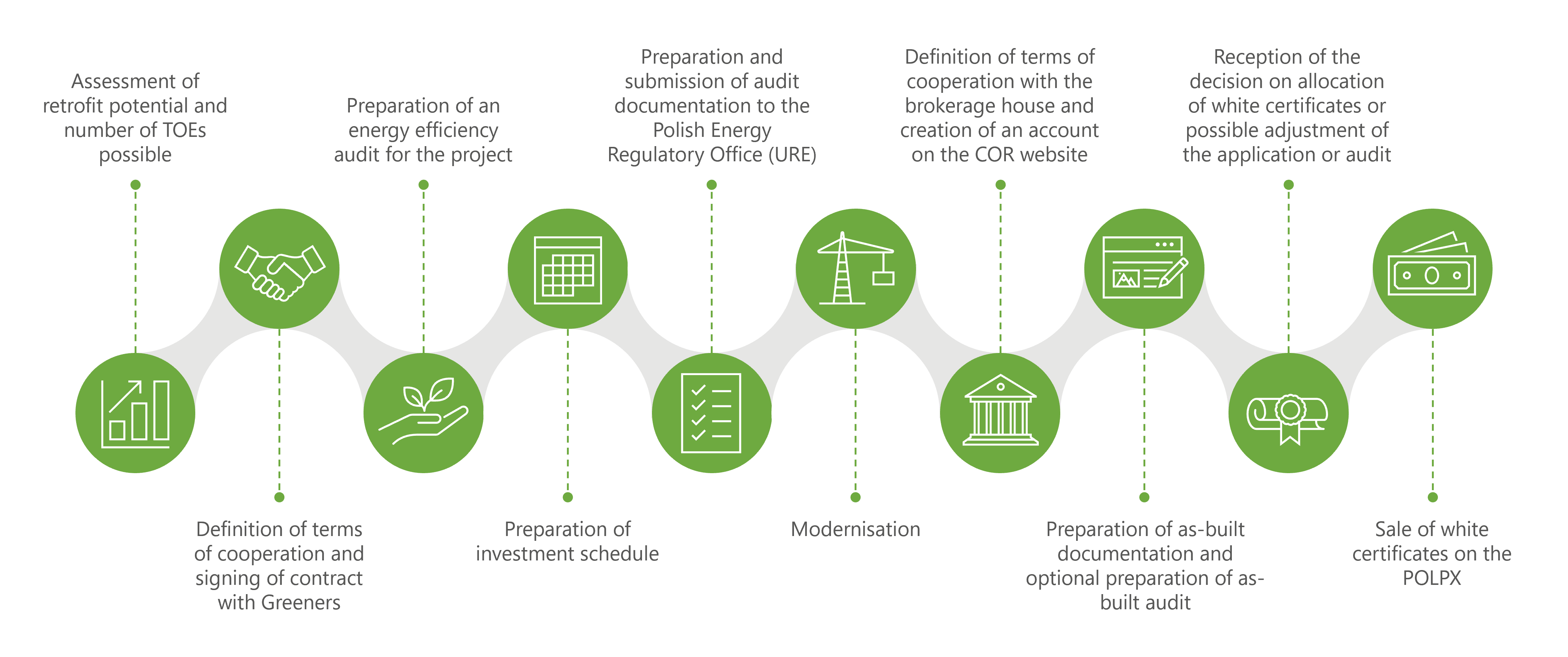Energy Efficiency Certificates (white certificates)
The Energy Efficiency Certificates (EEC) scheme was prepared pursuant to an obligation imposed on Member States by Directive 2012/27/EU of the European Parliament and of the Council (now recast as Directive 2023/1791). This obligation introduces a system requiring energy efficiency improvements so that a country’s energy distributors save at least 1.5% of their annual sales volume to end-users each year. Member States enjoyed some degree of freedom in developing and implementing this system. Poland decided to implement white certificates, which already existed in other European Union (EU) countries. The principles of the system and the provisions of the Directive (including the obligation for energy distributors to save energy) were implemented into Polish law by the Energy Efficiency Act (EEA).
How do EECs work?
EECs allow any entity that meets the conditions of the EEA to receive additional cash for performing energy efficiency improvements that result in energy savings.
The additional cash comes from white certificates, which are a property right tradable on the Polish Power Exchange (TGE). The certificates themselves are a document declaring a specific amount of energy saved (1 white certificate = 1 toe = 11.63 MWh = 41.868 GJ).
It is important to note that certificates are only granted for planned projects, i.e. projects that have not formally commenced through an order or a contractual obligation. An exception to this rule applies to companies whose annual electricity consumption exceeds 100 GWh and corresponds to the specific types of trades listed in the EEA.
Under the EEA and Directive 2023/1791, energy producers and distributors are required to achieve annual energy savings equal to 1.5 % of their annual sales volume. EECs are intended to help achieve this goal.
Entities to which the EEA applies are obliged to send a specific number of white certificates to the President of the Energy Regulatory Office (ERO). The number of white certificates which an entity must send varies according to the size of its obligation. The entity can obtain certificates by independently making investments to improve energy efficiency in its areas of activity. However, this is not always possible, so another option is to buy EECs via the TGE. Entities which possess the necessary certificates benefit from steady demand and can achieve additional financial benefits from modernising the fixed assets used in their operations.
Who can benefit from white certificates?
Any entity meeting the conditions of the EEA can benefit from the white certificate scheme.
The most important of these conditions is the incentive effect, which is mandatory. The scheme incentivises energy savings by ensuring that white certificates may only be issued in respect of projects in the planning phase. This means that an application for certificates must be submitted before the investment starts (i.e. before the relevant contract is signed with the contractor or before an order for materials is placed).
Another important condition concerns the specific level of energy savings which must be achieved. Projects which are eligible to participate in the white certificates scheme must involve a modernisation which results in final energy savings of at least 10 toe (116.300 MWh = 418.68 GJ).
It is not possible to obtain white certificates for investments which received state aid or a thermo-modernisation bonus (unless the value of certificates granted would not exceed the maximum amount of state aid), nor for investments in installations which are part of the greenhouse gas emission trading scheme, together with renewable energy sources.
Obtaining white certificates
- First, a careful analysis of the proposed modernisation is required, to confirm that it is eligible to participate in the white certificate scheme. Based on this information and the data provided by the contracting authority, the potential final energy savings are determined. If they exceed 10 toe, the project is eligible to apply for a white certificate and a cooperation agreement can be concluded.
- Next, an audit is prepared with an investment schedule. The application is then submitted to the ERO and the retrofitting can officially begin the next day.
- After completing the investment, as-built documents (e.g. works acceptance protocol, agreement with the investment contractor, order for materials, invoices) are collected and submitted to the ERO together with information on the project’s completion.
- For some investments, an as-built audit is required. This applies to investments in which:
- final energy savings exceeding 100 toe (1,163.000 MWh or 4,186.800 GJ) were demonstrated at the initial stage;
- after the contract was signed, it was decided to purchase different equipment or use different materials than those specified in the project design.
- Finally, the completed documentation on implementation of the investment is submitted to the ERO. Unless the ERO seeks further clarifications, it issues the EEC, which the company can monetise on the TGE.

Investments eligible to participate in the white certificates scheme
The types of modernisations which improve energy efficiency and are eligible to apply for white certificates are those which:
- insulate industrial installations;
- reconstruct or renovate buildings containing technical installations and equipment;
- modernise or replace:
- lighting;
- equipment or installations used in industrial, energy, telecommunications or IT processes;
- local district heating networks and local heat sources within the meaning of Article 2 (6) and (7) of the Act of 21 November 2008 on support for thermomodernisation and renovation and on the central register of building emissions;
- appliances intended for domestic use;
- vehicles for road or rail transport;
- energy recovery, including energy recovery in industrial processes;
- reduce energy losses:
- related to reactive energy consumption;
- network losses associated with the transmission or distribution of electricity, natural gas or liquid fuels;
- on transformation;
- on district heating networks;
- related to power supply systems for telecommunication or IT equipment;
- related to the storage and handling of liquid fuels;
- use energy generated in renewable energy source installations to heat or cool high-efficiency cogeneration facilities within the meaning of the Act of 10 April 1997 – Energy Law, or waste heat from industrial installations.
EECs are a financial instrument that can significantly improve the financial parameters of a potential investment. The scope of modernisation covers a wide range of investment projects, from replacing lighting to implementing the thermal modernisation of buildings and modernising industrial lines or cogeneration installations. The obligation for companies to redeem white certificates guarantees the secured monetisation of the property rights granted by EECs. Depending on the investment type, the application process can be very short.
The Greeners team comprises experts who have helped companies in various sectors to obtain additional financing under the EEC scheme. This allows us to provide comprehensive support for your investment.
April 18, 2024
Recent news
Kontrakt różnicowy i nowe możliwości dla przemysłu energochłonnego
W obliczu rosnących kosztów energii i presji konkurencyjnej, przemysł energochłonny w Polsce potrzebuje stabilnych i przewidywalnych warunków działania. Minister Rozwoju i Technologii Krzysztof Paszyk podczas konferencji 6 czerwca 2025 r. zapowiedział wprowadzenie nowego mechanizmu wsparcia – kontraktu różnicowego, który ma wejść w życie od 2026 roku.
Nowe perspektywy rozwoju dla hut dzięki Funduszowi Bezpieczeństwa i Obronności (FBiO)
W odpowiedzi na dynamicznie zmieniające się potrzeby w zakresie bezpieczeństwa narodowego i modernizacji infrastruktury strategicznej, polski rząd uruchamia Fundusz Bezpieczeństwa i Obronności (FBiO) – nowy mechanizm finansowania zasilany ze środków Krajowego Planu Odbudowy (KPO). Co istotne, wsparcie obejmuje również sektor hutniczy – zwłaszcza ten powiązany z produkcją komponentów dla przemysłu obronnego oraz infrastrukturę o podwójnym zastosowaniu (dual-use).
Szkolenie „Efektywność energetyczna jako fundament długoterminowych oszczędności i niskiej emisji”
Zespół Greeners, SSW oraz Konfederacja Lewiatan serdecznie zapraszają na konferencję „Ślad węglowy – Raport z badania polskich przedsiębiorstw”, która odbędzie się 1 kwietnia 2025 r. w Warszawie (Rondo ONZ 1, p. 12). Podczas wydarzenia zaprezentujemy wyniki naszego badania ankietowego, a także zaprosimy Państwa do udziału w dwóch panelach dyskusyjnych z udziałem ekspertów i przedstawicieli biznesu.
Energy transition of your company
We specialize in implementing sustainable development solutions that deliver tangible benefits to our clients.
